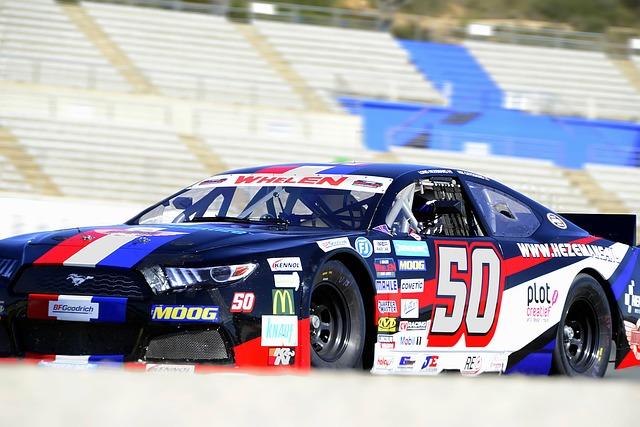in a turbulent turn of events within the world of motorsports,NASCAR’s recent charter negotiations have sparked controversy and dialog among race teams and stakeholders. Reports have surfaced detailing NASCAR’s internal stance on the Superstar Racing experience (SRX), with unnamed sources indicating that the sanctioning body is seeking too undermine SRX’s growing influence by metaphorically suggesting that a “knife” be put into the “trash” of the budding series.As interest in SRX continues to build, these developments raise critical questions about the future of both organizations and the competitive landscape of auto racing. This article delves into the implications of these negotiations, the response from SRX officials, and what this could mean for fans and participants alike.
NASCAR’s Strategic Maneuvering during Charter Negotiations Reveals Tensions with SRX
NASCAR’s recent charter negotiations have shed light on underlying tensions with the Superstar Racing Experience (SRX),a series that has quickly captured the attention of motorsport enthusiasts. Reports suggest that during discussions, NASCAR officials expressed a desire to put a metaphorical “knife” into what they perceived as the “trash” that SRX represents in the world of professional racing. This statement reflects a growing concern within NASCAR regarding the influence and appeal of competing racing series. Key points from these negotiations include:
- Competitive Pricing: NASCAR’s insistence on maintaining stringent charter costs to protect its existing teams.
- Market Saturation: Concerns over the saturation of the racing market amidst the rising popularity of SRX.
- Team Ownership Focus: Prioritization of charter member interests over external series that threaten conventional racing dynamics.
The friction between the two entities is not merely a business matter; it also points to a philosophical divide in how racing should be promoted and structured. For many in NASCAR, SRX embodies an alternative vision that de-emphasizes grand spectacles in favor of grassroots racing experiences. This could potentially erode NASCAR’s credibility and financial security. The following table illustrates some of the contrasting elements of the two racing formats:
| Feature | NASCAR | SRX |
|---|---|---|
| Race Format | Longer races with complex strategies | Shorter, high-energy events |
| Team Structure | Established teams with charters | Seasonal roster with various drivers |
| Fan Engagement | Focused on a loyal fan base | Appeals to new, younger audiences |
analyzing the Implications of NASCAR’s Stance on SRX for Future Racing Partnerships
NASCAR’s recent interactions with the Superstar Racing Experience (SRX) have raised eyebrows, particularly as they suggest a more aggressive stance towards non-NASCAR sanctioned series. Sources indicate that during charter negotiations,NASCAR executives contemplated methods to diminish SRX’s influence,even considering the metaphorical act of putting a ‘knife’ into what they viewed as ‘trash’. This approach illustrates a growing concern within NASCAR about the potential competition posed by emerging racing formats that attract fans and talent away from traditional stock car racing. Such a philosophy may reshape the landscape of racing partnerships, igniting a crucial dialogue about exclusivity and collaboration in the industry.
As NASCAR navigates these waters, it faces several key challenges that could redefine future collaborations:
- Partnership Dynamics: A confrontational approach may deter potential partners who seek a more cooperative environment.
- Fan Engagement: Fans of diverse racing styles could feel alienated if NASCAR focuses solely on its brand identity.
- Talent Drain: Competitors like SRX may attract top drivers, thereby diluting NASCAR’s talent pool.
To quantify the potential impact, a brief comparison of both series could provide insight:
| Feature | NASCAR | SRX |
|---|---|---|
| Series Length | Year-round | Summer Series |
| Race Format | Oval Tracks | Variety of Tracks |
| Target Audience | Traditional Fans | New demographics |
NASCAR’s decision to either embrace or challenge entities like SRX will fundamentally shape its viability and growth in an increasingly competitive racing ecosystem. How they proceed with these tensions may well determine the future of not only their brand but the entire landscape of professional motorsports in America.
Recommendations for SRX to navigate the Shifting Landscape of Stock Car Racing Relations
In light of recent tensions and negotiations surrounding charters, SRX must adopt a multifaceted approach to reinforce its position in the evolving stock car racing ecosystem. Fostering strategic partnerships with grassroots racing organizations can expand SRX’s reach while enhancing its credibility. by aligning with local tracks and racing leagues, SRX can bolster its grassroots appeal, ensuring that it remains relevant to passionate racing fans. Additionally, enhancing its outreach and engagement on social media platforms will help create a community around SRX, encouraging fan loyalty and participation, which is crucial in a competitive environment.
Moreover, diversifying its racing schedule to include more varied tracks can attract a broader audience and keep the competition fresh. This includes exploring opportunities to feature road courses alongside the traditional oval tracks, which can appeal to a different demographic of motorsports enthusiasts. SRX should also consider developing a robust developmental program for emerging drivers,creating a new talent pipeline that revitalizes the series and captures the interest of racing purists and new fans alike. By proactively addressing these areas, SRX can not only navigate the current landscape but also thrive within it.
Wrapping Up
the recent discussions surrounding NASCAR’s negotiations over charters have revealed a contentious stance towards the Superstar Racing Experience (SRX). With calls for a radical approach to removing SRX from the competitive landscape, it’s clear that the tension between the two entities is reaching a boiling point. As both sides weigh their options, the implications of these negotiations could have far-reaching effects on the future of short track racing.as the situation develops, stakeholders in the motorsport community will be watching closely to see how these contentious issues unfold and shape the trajectory of American auto racing. Stay tuned for more updates as we continue to follow this evolving story.








